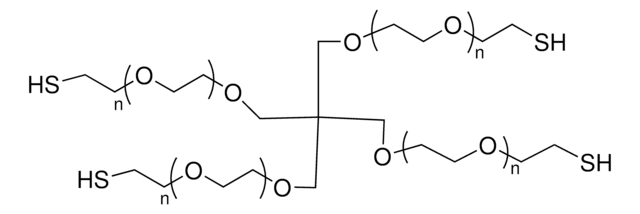JKA8027
8arm-PEG10K
average Mn 10,000, Maleimide, hexaglycerol core, thiol reactive
Synonym(s):
8arm-PEG-Maleimide, Polyethylene glycol
About This Item
Recommended Products
product name
8arm-PEG10K-Maleimide, hexaglycerol core, average Mn 10,000
form
solid
mol wt
average Mn 10,000
reaction suitability
reactivity: thiol reactive
polymer architecture
shape: 8-arm
functionality: homofunctional
storage temp.
−20°C
Looking for similar products? Visit Product Comparison Guide
General description
Application
Legal Information
Storage Class Code
11 - Combustible Solids
WGK
WGK 3
Flash Point(F)
Not applicable
Flash Point(C)
Not applicable
Regulatory Listings
Regulatory Listings are mainly provided for chemical products. Only limited information can be provided here for non-chemical products. No entry means none of the components are listed. It is the user’s obligation to ensure the safe and legal use of the product.
JAN Code
JKA8027-1G:
Choose from one of the most recent versions:
Certificates of Analysis (COA)
Sorry, we don't have COAs for this product available online at this time.
If you need assistance, please contact Customer Support.
Already Own This Product?
Find documentation for the products that you have recently purchased in the Document Library.
Customers Also Viewed
Articles
The immune system protects the body from disease by resisting the invasion of foreign molecules into its cells, for example peptides and proteins are hydrolyzed by proteolytic enzymes; nucleic acids are hydrolyzed by nucleases; and most small molecules are eliminated in the liver and kidneys.
Our team of scientists has experience in all areas of research including Life Science, Material Science, Chemical Synthesis, Chromatography, Analytical and many others.
Contact Technical Service
